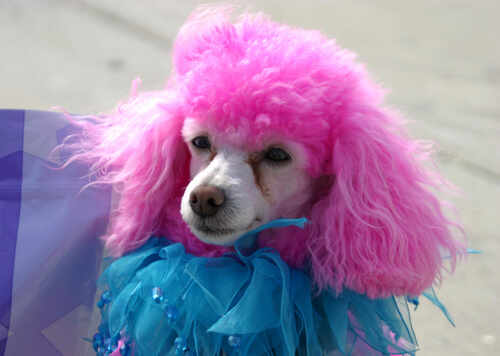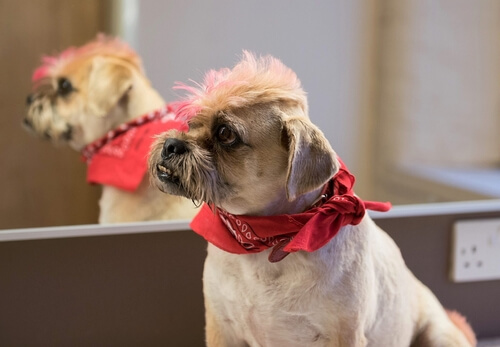The Dangers of Dyeing an Animal's Fur

Maybe you’ve seen oddly-colored rabbits or parakeets for sale in parks or stores. Or perhaps you’ve seen videos and pictures on the internet of dogs and cats with colorful hair. While it may seem funny, the truth is that dyeing an animal’s fur exposes them to serious health risks. Keep on reading to find out why…
The Fur-Dyeing Trend
First it was a fad that originated in Tokyo and later expanded to Beijing. Of course, it didn’t take long for the trend to migrate to other parts of the world, like Paris, London and New York. Dogs with dyed fur would go out on the street for walks with their owners, who enjoyed the attention.
It doesn’t matter what the reasons are that lead a person to dye their pet’s fur or to buy an animal whose fur has been dyed; what people should be worried about are the negative consequences that these actions have on the animals in question.
1. It can be poisonous
The dyes that are used for altering the color of an animal’s fur are appropriate for use on human beings, but they must not be used on animals. They contain certain harmful substances that can cause irreversible health issues.
For one, when the products come in contact with the animal’s skin, it permeates the dermis and travels to the inside of the animal’s body. In addition, they clog the animal’s pores and don’t allow toxins out. As if all this were not enough, the toxins then cause irritation, itching, burns, eczema and other skin problems.

Likewise, there is another factor that must be taken into account: when it comes to dogs and cats, they will inevitably lick themselves because the dye will be itchy, and the toxins can shut down the animal’s digestive system! This can cause vomiting, diarrhea and even death.
2. It can cause allergic reactions
Although in recent times there have been a few dyes developed specifically for pets, the truth is that even then they may not be safe. Many animals are allergic to the ingredients in them. In fact, the reaction can be just as bad as with dyes meant for humans.
Always remember that dogs and cats have very delicate skin. Therefore, you shouldn’t even bathe your pets with the same shampoo you use.
3. Dyeing an animal’s fur is stressful
If you are thinking about dyeing an animal’s fur, there’s something else you should know. The dyeing process is much more stressful for an animal than getting a bath. It can be quite upsetting for them.
Getting the animal’s fur wet, applying the dye, letting the dye take effect, and rinsing and drying it may very well take an hour. The entire time, your dog may be scared and even bite you.
4. It changes their behavior
Dyeing an animal’s fur is completely unnatural. They already have a certain color to their fur and there’s no reason to change it. If you do, it can alter their behavior. Many dogs won’t want to go for a walk or get out of bed. Something similar thing happens when they get their fur trimmed in the summer.

If a dog isn’t in contact with others of his species, he could get stressed and anxious. He could also develop behavioral problems. Don’t forget that socialization starting at an early age is very important.
5. Dyeing an animal’s fur changes their natural odor
Even if we put aside for a moment how toxic dyes can be, you must bear in mind that the dye’s particular aroma will camouflage your pet’s natural smell, meaning they won’t be able to communicate properly!
Therefore, even if people smile when they see a green dog, other animals will reject them and not approach them. It’s not fair for an animal to have to endure this. They shouldn’t have to suffer for a decision their owner made on a whim.
6. It is treating them like a human
This is yet another trend that unfortunately is very toxic for your pet. Even if you love them a lot, your pet is not a person, much less your baby. ‘Humanizing’ dogs and cats is harmful to them. They won’t obey the rules or relate to other animals well, to name just a few things.
This text is provided for informational purposes only and does not replace consultation with a professional. If in doubt, consult your specialist.